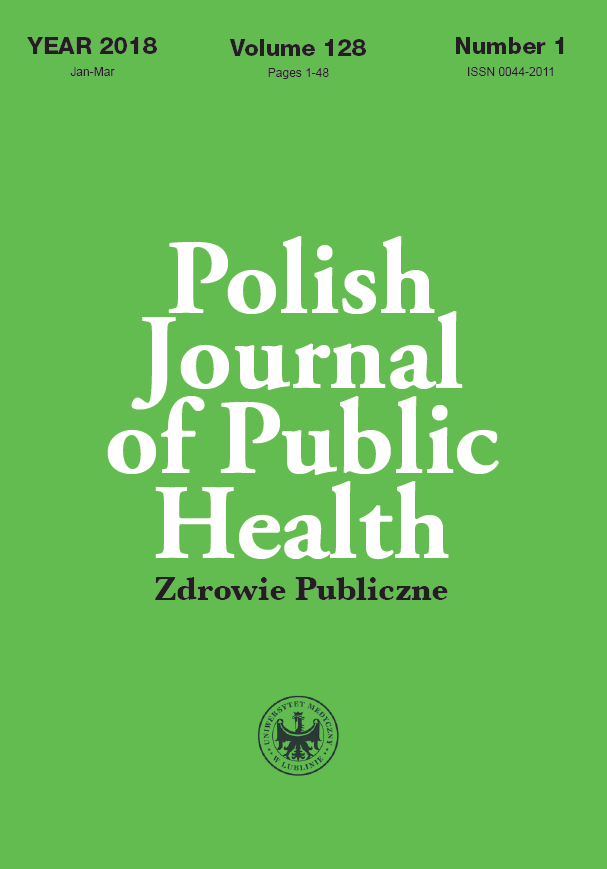Assessment of the severity of the stress levels of women in childbirth
DOI:
https://doi.org/10.2478/pjph-2018-0001Keywords:
childbirth, stress, educationAbstract
Introduction. It is well known that the period of maternity commencing from conception is accompanied by great emotions. Each stage is associated with specific behavior as well as the anxiety. The postpartum period is particularly exposed to stress and the ability to overcome it is very important, therefore the support of the loved ones is necessary.
Aim. Assessment of the severity of the stress levels of women in childbirth.
Material and methods. The research was conducted among 178 women during the postpartum period. The methods of diagnostic survey and own questionnaires were used, as well as PSS-10 standardized tool.
Results. The study involved 178 women during the postpartum period. Interpretation of results for the level of stent PSS-10 showed low results – 23.6%, average – 32.6%, high – 43.8% due to a high stress level. Statistically significant factors are: marital status - married women experience lower stress levels, socioeconomic status – the higher socioeconomic status, the test group felt lower stress, birth time – there is a significant difference between women giving birth before 37 weeks and those giving birth in right term. Particular age group, place of residence, education, the number of births and the way of birth are not factors that differentiate levels of perceived stress of women in childbirth.
Conclusions. Perinatal period is a time of dynamic changes characterized by high levels of stress. Age, place of residence, education, number of births and way of birth do not affect the level of stress, whereas marital status, socioeconomic situation and the date of birth determine stress levels for women.
References
1. Hillerer KM, Neumann ID, Slattery DA. From Stress to Post-partum Mood and Anxiety Disorders: How Chronic Peripar-tum Stress Can Impair Ma¬ternal Adaptations. Neuroendocrinology. 2011;1-17.
2. Littleton HL, Bye K, Buck K, et al. Psychosocial stress during pregnancy and perinatal outcomes: A meta-analytic review. J Psychosom Obst Gyn. 2010;31(4):219-28.
3. Mitręga A. Matczyne debiuty. Obrazy doświadczania pierwszych tygodni macierzyństwa. Kultura – Społeczeństwo – Edukacja. 2014;1(5):55-72.
4. Gjerdingen D, Fontaine P, Crow S. Predictors of mothers’ postpartum body dissatisfaction. Women and Health. 2009;49:491-504.
5. Sikorska M.: Nowy ojciec, nowa matka, nowe dziecko. Warszawa: Wydawnictwo Akademickie i Profesjonalne; 2010.
6. Czapiński J.: Strategie radzenia sobie z problemami i trudnościami (W:) Czapiński J, Panek T. Diagnoza Społeczna 2015. Warunki i jakość życia Polaków. Warszawa: Wyd. Contemporary Economics; 2015. p. 268-70.
7. Makara-Studzińska M, Zwierz K, Madej A, Wdowiak A. Sposoby radze¬nia sobie ze stresem kobiet we wczesnym połogu. J Public Health Nurs Med Rescue. 2015;4:38-43.
8. Walker LO, Xie B, Hendrickson SG, Sterling BS. Behavioral and psycho¬social health of new mothers and associations with contextual factors and perceived health. J Obstet Gynecol Neonatal Nurs. 2016;45(1):3.
9. Cheng CY, Pickler RH. Perinatal stress, fatigue, depressive symptoms, and immune modulation in late pregnancy and one month postpartum. Scien¬tific World Journal. 2014;65(2):63-70.
10. Rutkowska A, Rolińska A, Kwaśniewski W. Style radzenia sobie ze stre¬sem u kobiet w ciąży prawidłowej i wysokiego ryzyka. Curr Probl Psy¬chiatry. 2010;11(4):328-33.
11. Terelak J. :Rola wsparcia społecznego w radzeniu sobie ze stresem. Meri¬tum. 2010;4:31-6.
12. Kossakowska K. Źródła wsparcia społecznego i wybrane sposoby radzenia sobie u kobiet z objawami depresji poporodowej. Probl Pielęg. 2012;20(3):310-6.
13. Kowalska J, Olszowa D, Markowska D, et al. Aktywność fizyczna i szkoła rodzenia w czasie ciąży a poziom postrzeganego stresu i objawów depr¬esyjnych u kobiet po porodzie. Psychiatr Pol. 2014;48(5):889-900.
14. Chaaya M, Osman H, Naassan G, et al. Validation of the Arabic version of the Cohen perceived stress scale (PSS - 10) among pregnant and postpar¬tum women. BMC Psychiatry 2010, 10: 111-118.
15. Juczyński Z, Ogińska-Bulik N. Skala Odczuwanego Stresu (PSS-10). In: Z. Juczyński, N. Ogińska-Bulik. (ed). Narzędzia Pomiaru Stresu i Radze¬nia Sobie ze Stresem. Warszawa: Pracownia Testów Psychologicznych; 2009. p.11-22.
16. Piech B. Wpływ warunków i stylu życia na poziom lęku kobiet w okresie połogu – badanie ankietowe. Prz Lek. 2017;74(3):101-5.
17. Błaszczak A, Pilch D, Szamlewska B. Badanie poziomu lęku kwestionari¬uszem STAI CD Spielbergera u kobiet w okresie okołoporodowym. Peri¬natol Neonatol Ginekol. 2011;4(3):163-8.
18. Libera A. Problemy psychologiczne okresu ciąży, Psychologiczne aspekty ciąży. In: M. Makara-Studzińska, G. Iwanowicz-Palus (ed). Psychologia w położnictwie i ginekologii. Warszawa: Wydawnictwo Lekarskie PZWL; 2009. p.154-7.
19. Mojs E, Czarnecka-Iwańczuk M, Głowacka MD. Poziom lęku jako stanu i jako cechy oraz depresji we wczesnym połogu - doniesienia wstępne. Psychiatr Pol. 2013;47(1):31-40.
Downloads
Published
Issue
Section
License
Copyright (c) 2018 Polish Journal of Public Health

This work is licensed under a Creative Commons Attribution-NonCommercial-NoDerivatives 3.0 Unported License.


